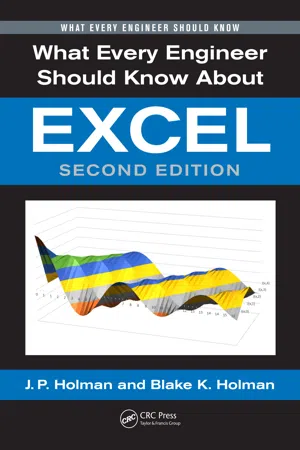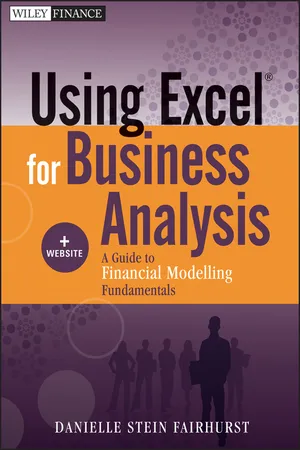Technology & Engineering
Excel Errors
Excel errors refer to mistakes or issues that occur when using Microsoft Excel, a popular spreadsheet program. These errors can include formula errors, such as #DIV/0! or #VALUE!, as well as issues with data input, formatting, and functions. Identifying and resolving Excel errors is important for ensuring accurate data analysis and reporting.
Written by Perlego with AI-assistance
Related key terms
Related key terms
1 of 4
Related key terms
1 of 3
3 Key excerpts on "Excel Errors"
- eBook - ePub
- Steven L. Danver(Author)
- 2016(Publication Date)
- SAGE Publications, Inc(Publisher)
Still another source of error is that often, corporate spreadsheets are changed by someone other than the original author and this may cause errors to propagate. Many corporations have standard operating procedures that use spreadsheets to support the business case for new investments, for example. These spreadsheets usually calculate the net present value and internal rate of return simultaneously. Thus, investment decisions may be wrong if the spreadsheets used to support the decision-making process are not correct. Therefore, spreadsheet creators and users in the real world need to be aware that errors do happen. A 2008 research study estimated that approximately 94% of all spreadsheets used in industry contain errors, so just because a computer did the calculation does not mean the resulting numbers are correct. However, a 2009 research study concluded that 40% of spreadsheet errors had no significant quantitative effect on the final results. These error rates seem to be much too high, and all spreadsheet users need to establish policies to discover errors in any spreadsheets that they use.Implications for Educators
Spreadsheet software is normally sold without any explanatory manuals, and the built-in help screens are often not as useful as most users expect, so they usually do not use the help menu. This disconnect may be due to the fact that it is difficult for computer programmers and technical writers to imagine the difficulties that naive users might have. Therefore, since spreadsheets are likely to be widely used by students, professors, and their university administrators, everyone needs to be aware that errors are very likely and not all of the spreadsheet functions work as the textbooks lead students and professors to believe. This is especially important for business, engineering, and statistics students and professors. Since almost all academic disciplines use statistics, naive users might use Excel without being aware that the functions they are most likely to use probably cannot be trusted to calculate accurately.Alfred KahlSee also Mathematics Education ; Open Source Teaching Tools ; Quantitative Methods and Research ; TabletsFurther Readings
Howe , H., &Simkin , M.(2006 ). Factors affecting the ability to detect spreadsheet errors . Decision Sciences Journal of Innovative Education , 4 (1) , 101 –122 .Jelen , B.(2013 ). Excel 2013 in depth . Indianapolis, IN : Que .Kanyarusoke , K., &Uziak , J.(2009 ) Spreadsheets: The ideal tool for distance learning in engineering education . Computer Applications in Engineering Education - eBook - ePub
- J. P. Holman, Blake K. Holman(Authors)
- 2017(Publication Date)
- CRC Press(Publisher)
Introduction1.1 Getting the Most from Microsoft Excel
Microsoft Excel is a deceptive software package in that it offers computation and graphics capabilities far beyond what one would expect in a spreadsheet tool. Its capabilities remain unknown to many engineers and technical persons, although more engineers are adopting its use. This book is written for the person who is casually familiar with Excel but is unaware of its broad potential. Although a novice will find the material useful, it will be most attractive to those who have the following:- A basic knowledge of both Excel and Microsoft Word, including procedures for entering equations in Excel, editing fundamentals, and some experience with creating graphs
- A basic knowledge of differential and integral calculus
- For some sections, a familiarity with solution techniques for single and simultaneous equations
- For some sections, a familiarity with basic statistics, including the concepts of standard deviation and probability
Many of the sections in this book resulted from small instructional sets that were written as stand-alone packages for engineering students enrolled in a mechanical engineering curriculum. In addition, some of the sets and example problems are related to applications in the thermal and fluids sciences areas of mechanical engineering. Although these application examples are retained, they are presented as part of more general procedures that are applicable to other engineering and technical disciplines.Unless a person works with a software package such as Excel on a continual basis, it is easy to forget some of the shortcuts and nuances of operation that accomplish calculation or presentation objectives, namely procedures for viewing all equations on a worksheet, inserting symbols in equations, etc. Such hints are presented in compact form for the reader’s convenience. - eBook - ePub
Using Excel for Business Analysis
A Guide to Financial Modelling Fundamentals
- Danielle Stein Fairhurst(Author)
- 2012(Publication Date)
- Wiley(Publisher)
A well-built financial model or piece of analysis is an invaluable tool in decision making and financial management, but all too often a wrong calculation can have disastrous consequences. Many executives and decision makers rely far too heavily on Excel models—probably because they don’t fully understand the risks involved.There are many well-documented cases of high-profile Excel model blunders. Some of those documented by EuSpRiG, the European Spreadsheets Risks Interest Group, include1 :- The auditor’s office that divided the growth from one year to the next by the second year, rather than the first year, specifically, calculated it using (Year 2 – Year 1)/Year 2 instead of (Year 2 – Year 1)/Year 1.
- Aspiring police officers were told they passed an exam only to discover that the administrators had incorrectly sorted the results to the names and scores were mismatched.
- A gas company submitted the wrong week’s gas storage figures, leading to artificial inflation of natural-gas prices and a lawsuit.
- Shares of a self-storage company dropped when it was disclosed that it had overpaid its chief executive and another investor $700,000 each and took more than six months to find and correct the error, which was due to using the wrong spreadsheet.
The list of Excel horror stories continues to grow, reminding us that simple mistakes in spreadsheet and financial models can cause companies to lose significant amounts of money—not to mention the resulting embarrassment.Figure 4.1 is an example of one of many very simple and yet common formula mistakes often found in Excel models. In the figure, row 13 has been entered, but it’s not been picked up in the summary total below it.FIGURE 4.1 Common Excel Error in ModellingTo avoid this error, when creating summary totals, leave an extra gap row between the last row of values and the sum formula. Therefore, when new rows are inserted, the summation formula will automatically include the newly inserted rows. This will minimise the chance of error when the model needs to be expanded. The use of error checks can also help to alert the user or modeller when this happens.
Index pages curate the most relevant extracts from our library of academic textbooks. They’ve been created using an in-house natural language model (NLM), each adding context and meaning to key research topics.
Explore more topic indexes
Explore more topic indexes
1 of 6
Explore more topic indexes
1 of 4


